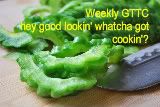Gardeners are an adventurous
lot – to a point. We love trying new
vegetables, exotics we’ve never heard of before, based solely on descriptions
in glossy-paged seed catalogs. And those
catalogs are coming, if they haven’t already arrived, filling mailboxes and
covering kitchen tables even as they brighten dreary cold winter days. So we fill out the order forms or log on to
the websites, and select a new adventure, in the form of little paper packets
of seeds. Seasons turn, seeds get
planted, and crops grow. Now what?
Kiang-Spray (rhymes with
‘key-young’) answers that question, at least for Chinese vegetables, in The
Chinese Kitchen Garden. Laid out in four
seasons, The Chinese Kitchen garden takes us on a tour of 38 vegetables, some
you may never have heard of, others you may not have known are Chinese, many
with unexpected and delicious uses. Each
season opens with relevant garden tasks; among them soil building in spring,
pest and weed control in summer, harvest and storage in fall, season extension
and reflection in winter; before going on to present the stars of the
season. Each vegetable receives a
three-part treatment: general information including its name in Cantonese,
Mandarin, and Scientific notation, growing instructions, and cooking
instructions, rounded out with family favorite recipes.
Kiang-Spray’s instructions
demystify otherwise unfamiliar vegetables, taking the uncertainty out of
growing, harvesting and, most important, using these new kitchen exotics. She quickly takes the fear of the unknown out
of the equation.
So many gardening books tell
you how to grow something in intimate detail, but not what to do with it once
you’ve grown it. Not so
Kiang-Spray. She guides you through the
steps of each Chinese vegetable’s culture before leading you to the kitchen,
where she stands by your elbow, walking you through each recipe, telling you
what to expect, promising a personal taste of China. As an added treat, she shares a family secret
recipe, her favorite steamed dumplings.
Gorgeous photographs of
Kiang-Spray’s gardens, harvests, and family complement her prose
beautifully. Long beans, sliced lotus root,
and trellised luffa alternate with shots of her daughters, sister, parents, and
herself in and around the garden.
The Chinese Kitchen Garden is
not just about gardening or Chinese vegetables.
Rather, this is a book about food and family, how food brings family
together, how food can define a culture, a heritage, a sense of self, even a
bridge to one’s heritage. Kiang-Spray
weaves together memories of her childhood, stories of her parents’ lives, and
reports of her own daughters’ shenanigans, welcoming us into her world, at once
Chinese and American.
Throughout the book, she
compares her own, more ‘American’ gardening style to her father’s traditional
Chinese methods, drawing parallels and lessons from each. Be sure to read the
preface, as this is the story of her father, her mother, herself, and her
family. This serves as your introduction
to the family, and your invitation to the table. Kiang-Spray’s conversational voice continues
throughout the book, offering verbal snapshots of her home and her family. The Chinese Kitchen Garden is that rarest of
non-fiction books: a reference built for pleasure reading.
By Andrew Weidman

































